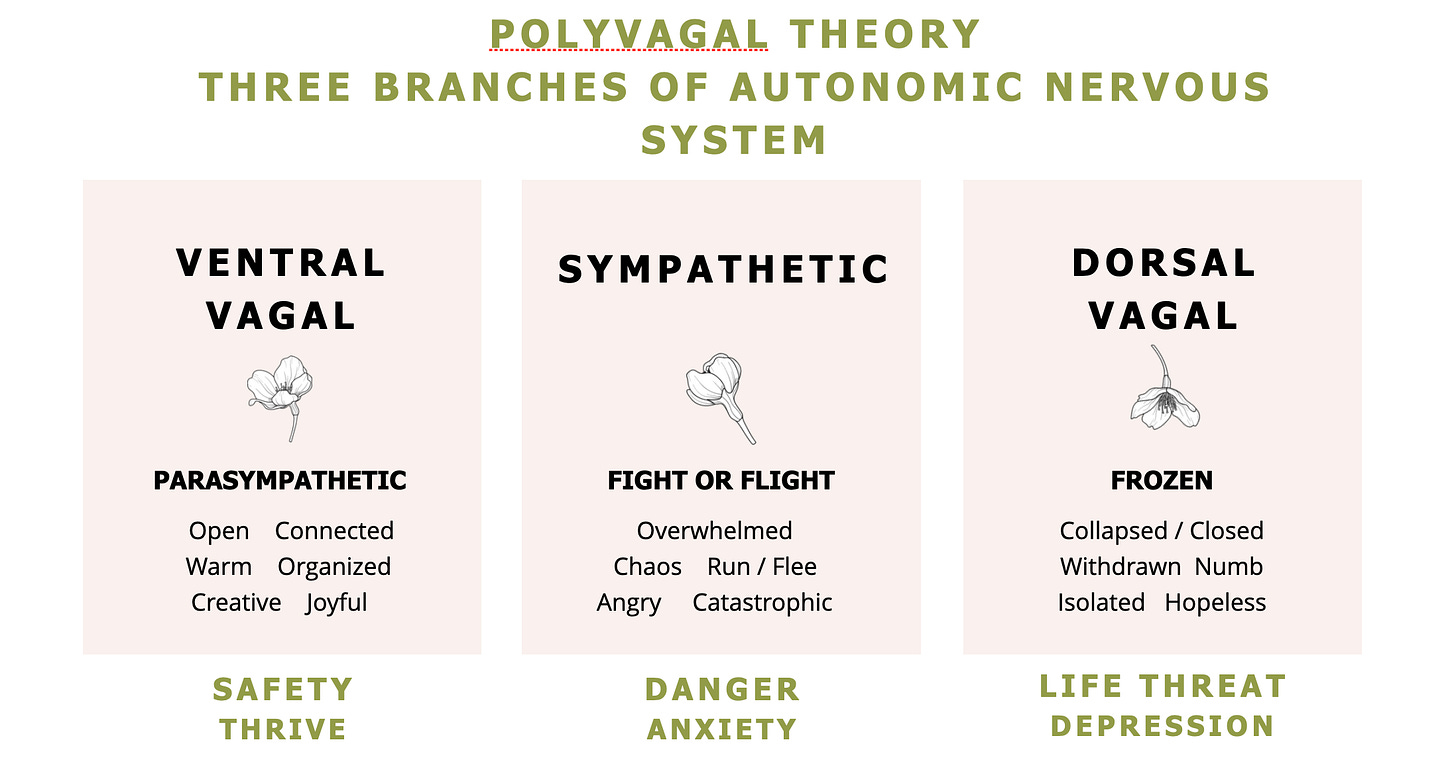This framework helps explain how our nervous system responds to stress and safety cues.
The Polyvagal Ladder
Dorsal Vagal State (Immobilization/Shutdown)
Characteristics: This is the most primitive response of the autonomic nervous system. It is characterized by a feeling of being frozen, disconnected, or shut down.
Physiological Responses: Reduced heart rate, slowed metabolism, and a sense of numbness or dissociation.
Behavioral Responses: Withdrawal from social interaction, feelings of hopelessness, and difficulty in taking action or making decisions.
Adaptive Function: This state is a survival mechanism that helps conserve energy during life-threatening situations. However, prolonged activation can lead to conditions such as depression and chronic fatigue.
Sympathetic State (Mobilization)
Characteristics: This state is associated with the fight-or-flight response. It prepares the body to respond to perceived threats.
Physiological Responses: Increased heart rate, elevated blood pressure, and heightened alertness.
Behavioral Responses: Aggression, anxiety, hyper-vigilance, and impulsivity.
Adaptive Function: This state enables quick responses to danger. However, chronic activation can lead to stress-related illnesses and anxiety disorders.
Ventral Vagal State (Social Engagement)
Characteristics: This is the most evolved state and is associated with feelings of safety, connection, and social engagement.
Physiological Responses: Balanced heart rate, normal digestion, and a sense of calm.
Behavioral Responses: Open communication, empathy, and the ability to form healthy relationships.
Adaptive Function: This state promotes social bonding, cooperation, and overall well-being. It is essential for recovery from stress and trauma.
Moving Up and Down the Ladder
Triggers and Cues: Our nervous system constantly scans the environment for cues of safety or danger, a process called neuroception. Positive cues (e.g., a warm smile, a soothing voice) help us move up the ladder towards the ventral vagal state. Negative cues (e.g., a loud noise, a threatening gesture) can push us down the ladder towards the sympathetic or dorsal vagal states.
Flexibility and Resilience: A healthy nervous system can move fluidly up and down the ladder, adapting to different situations. Resilience involves the ability to return to the ventral vagal state after experiencing stress.
Implications for Trauma Recovery: Understanding the Polyvagal Ladder is crucial in trauma recovery. Therapeutic approaches can focus on creating a sense of safety and fostering social connections, helping individuals move towards the ventral vagal state.
Applications of the Polyvagal Ladder
Therapy and Counseling
Techniques: Therapists can use body-oriented approaches, such as mindfulness and breathing exercises, to help clients regulate their autonomic states.
Goal: The aim is to create a safe therapeutic environment that encourages clients to access their ventral vagal state.
Education and Parenting
Approach: Educators and parents can use the principles of the Polyvagal Theory to create supportive environments that promote learning and emotional growth.
Strategies: Establishing routines, providing consistent positive reinforcement, and using calming techniques can help children feel safe and engaged.
Personal Development
Self-Awareness: Understanding one's own autonomic responses can enhance self-regulation and interpersonal relationships.
Practices: Engaging in activities that promote the ventral vagal state, such as yoga, meditation, and socializing, can improve overall well-being.
The Polyvagal Ladder is a powerful tool for understanding the complex interplay between our autonomic nervous system and behavior.
By recognizing the different states and their triggers, we can develop strategies to enhance our emotional regulation, build resilience, and foster deeper connections with others. Whether in therapy, education, or personal development, the insights from the Polyvagal Theory can guide us towards a healthier and more fulfilling life.






